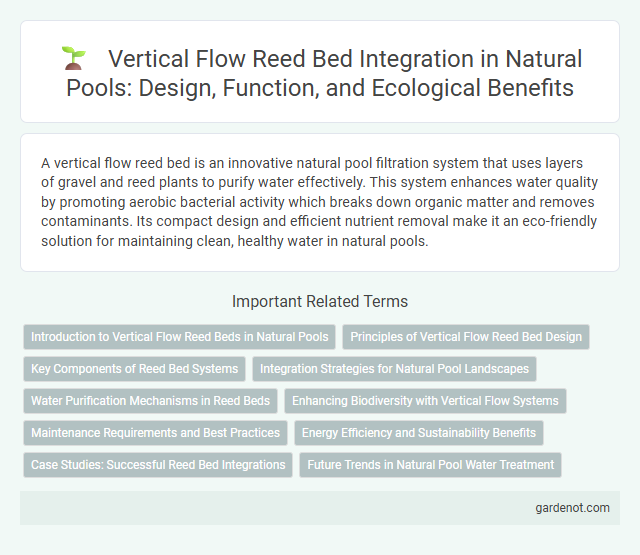A vertical flow reed bed is an innovative natural pool filtration system that uses layers of gravel and reed plants to purify water effectively. This system enhances water quality by promoting aerobic bacterial activity which breaks down organic matter and removes contaminants. Its compact design and efficient nutrient removal make it an eco-friendly solution for maintaining clean, healthy water in natural pools.
Introduction to Vertical Flow Reed Beds in Natural Pools
Vertical flow reed beds in natural pools utilize layered substrates and wetland plants to filter and purify water by promoting aerobic microbial activity. This eco-friendly system enhances water clarity and supports the pool's natural ecosystem by breaking down organic matter and removing nutrients. Designed for low maintenance, vertical flow reed beds integrate seamlessly into natural pool landscapes, ensuring sustainable water quality management.
Principles of Vertical Flow Reed Bed Design
Vertical flow reed beds operate by directing wastewater through a layered medium where reeds and microorganisms treat contaminants via aerobic processes. The design principles emphasize proper sizing of the bed, selection of substrate with adequate permeability, and maintaining intermittent loading to promote oxygen transfer. Ensuring optimized hydraulic retention time and uniform distribution supports efficient nutrient removal and sustainable natural pool water quality.
Key Components of Reed Bed Systems
Key components of vertical flow reed bed systems include a layered substrate composed of gravel and sand, which facilitates efficient wastewater filtration and microbial activity. The reed plants, primarily Phragmites australis, play a vital role in oxygenating the root zone and promoting pollutant breakdown. An effective drainage system ensures uniform water distribution and prevents clogging, optimizing the treatment process within the natural pool ecosystem.
Integration Strategies for Natural Pool Landscapes
Vertical flow reed beds enhance natural pool ecosystems by efficiently filtering water through layered gravel and plant roots, promoting habitat diversity and water clarity. Integrating vertical flow reed beds into natural pool landscapes involves strategic placement near pool edges to maximize nutrient uptake and support biofiltration processes. Utilizing native reed species and optimizing hydraulic loading rates ensures sustainable water circulation, improving overall pool health and aesthetic harmony.
Water Purification Mechanisms in Reed Beds
Vertical flow reed beds utilize a layered substrate where water flows downward through gravel and sand, allowing physical filtration of suspended solids. Microbial communities associated with reed roots break down organic matter and nutrients such as nitrogen and phosphorus via processes like nitrification and denitrification. The combination of root oxygen release and microbial activity enhances pollutant degradation, resulting in effective water purification in natural pool systems.
Enhancing Biodiversity with Vertical Flow Systems
Vertical flow reed beds enhance biodiversity by creating diverse microhabitats that support various aquatic plants, invertebrates, and microorganisms essential for natural pool ecosystems. These systems improve water quality by promoting oxygenation and nutrient cycling, fostering habitats for amphibians and beneficial insects. Integrating vertical flow reed beds optimizes ecological balance and resilience within natural pool environments.
Maintenance Requirements and Best Practices
Vertical flow reed beds in natural pool systems require regular inspections to ensure consistent water flow and prevent clogging caused by debris or root growth. Maintenance best practices include periodic removal of accumulated sediments, trimming of reeds to encourage healthy growth, and monitoring nutrient levels to avoid excessive biomass buildup. Implementing a scheduled cleaning routine enhances filtration efficiency and prolongs the lifespan of the reed bed, optimizing the natural purification process.
Energy Efficiency and Sustainability Benefits
Vertical flow reed beds enhance natural pool systems by efficiently filtering wastewater through layers of gravel and reeds, significantly reducing energy consumption compared to mechanical filtration. This eco-friendly technology promotes sustainable water management by leveraging natural microbial processes to break down pollutants and recycle nutrients. Incorporating vertical flow reed beds supports biodiversity and minimizes carbon footprint, aligning with green building and sustainable landscaping practices.
Case Studies: Successful Reed Bed Integrations
Vertical flow reed beds have demonstrated exceptional efficiency in natural pool water purification across various case studies, showing up to 90% reduction in organic pollutants and pathogens. Projects in Europe, such as the Biosphere Reserve in Germany and eco-resorts in Spain, highlight sustainable integration with minimal maintenance and zero chemical usage. These successful installations promote biodiversity, improve water clarity, and serve as scalable models for eco-friendly aquatic environments.
Future Trends in Natural Pool Water Treatment
Vertical flow reed beds are gaining prominence in natural pool water treatment due to their efficient biofiltration and low energy requirements. Emerging trends emphasize integrating smart monitoring sensors that optimize nutrient removal and microbial activity, enhancing water clarity and quality. Advancements in native plant selection and substrate innovation also contribute to more sustainable and resilient natural pool ecosystems.
Vertical flow reed bed Infographic

 gardenot.com
gardenot.com